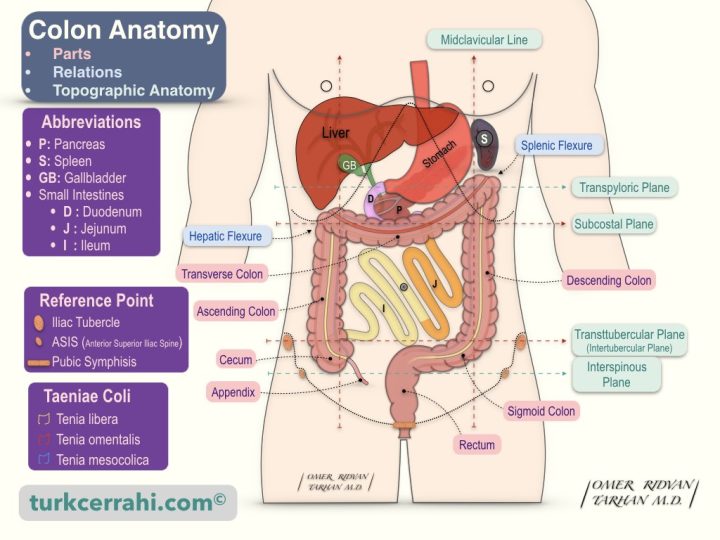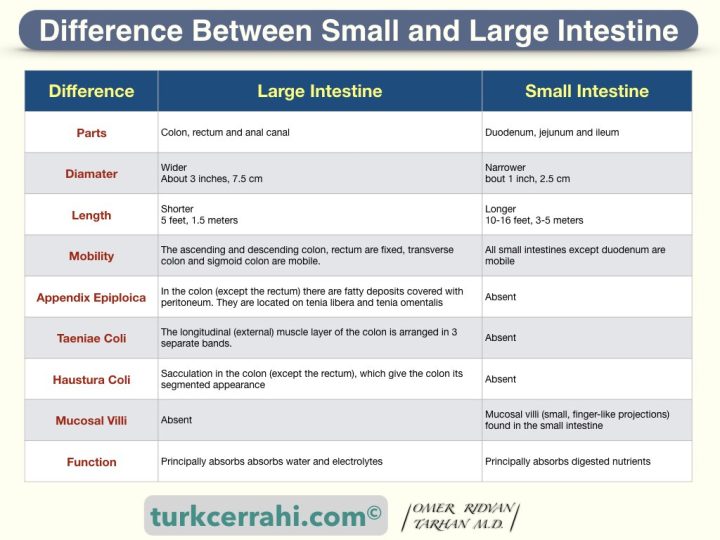Colon, Rectum, and Anus - Overview

1. Introduction
The large intestine, which consists of the colon, rectum, and anal canal, is the final component of the digestive system. The large intestine is approximately 150 cm in length and is significantly thicker than the small intestine, through which feces are formed and stored. The small intestine's liquid contents pass into the colon, which absorbs the water and salt and forms solid or semi-solid stools.
Colon and rectum cancers are in 3rd place in men and 2nd place in women in terms of cancer frequency worldwide, excluding skin cancer.
2. Anatomy
Parts of the large intestine
- Appendix
- Cecum
- Colon (ascending, transverse, descending, sigmoid)
- Rectum
- Anal canal.
The cecum is located in the right lower quadrant of the abdomen. The appendix is attached to the posteromedial wall of the cecum.
The large intestine begins in the right groin as the cecum. It then ascends through the right flank (the ascending colon) and attaches to the liver by the hepatocolic ligament. Then it makes a sharp turn to the left (the hepatic/right flexure in the right hypochondrium) and goes through the epigastrium to the spleen (the transverse colon). The splenocolic ligament connects the large intestine to the spleen. The large intestine curves down just below the spleen (splenic/left colic flexure in the left hypochondrium) and descends (descending colon) through the left flank and into the left groin.
The colon elongates in the left lower quadrant and makes an “S” (sigmoid colon). After the sigmoid colon, the colon runs straight from the pelvis to the anus (rectum). The colon is about 150 cm long, and the rectum is about 15 cm long. The anal canal is the last 4-5 cm of the large intestine.
The colon has three bands called taeniae that are not found in the small intestine (taenia coli, 120 degrees apart). Taeniae is a Latin word that means "ribbon." The longitudinal (external) muscle layer of the colon is arranged in 3 separate bands (with 120-degree intervals) called taenia coli. Taenia coli begins as three bands at the base of the cecum (at the root of the appendix); these three bands disperse in the rectum and surround the rectum and anal canal. The names of these three taenias are:
- Free taenia (taenia libera)
- Mesocolic taenia (tenia mesocolica)
- Epiploic taenia (taenia omentalis)
3. Differences Between Large and Small Intestines (Characteristics of the Large Intestine)

- The diameter of the large intestine is greater than that of the small intestine.
- Epiploic appendix: In the colon (except the rectum) there are fatty deposits covered with peritoneum. They are on taenia libera and tenia omentalis.
- Taenia Coli : The longitudinal (external) muscle layer of the colon is found in 3 bands (120 degrees apart). The taenia begin at the beginning of the colon (at the base of the cecum, at the root of the appendix), disperse in the rectum and anus. The names of these three taenias are;
- Free taenia (taenia libera)
- Mesocolic taenia (taenia mesocolica)
- Omental taenia (taenia omentalis)
- Hausura Coli: The sacculations of the colon, caused by the taenia, which are slightly shorter than the gut.
- The colon lacks the mucosal villi found in the small intestine.